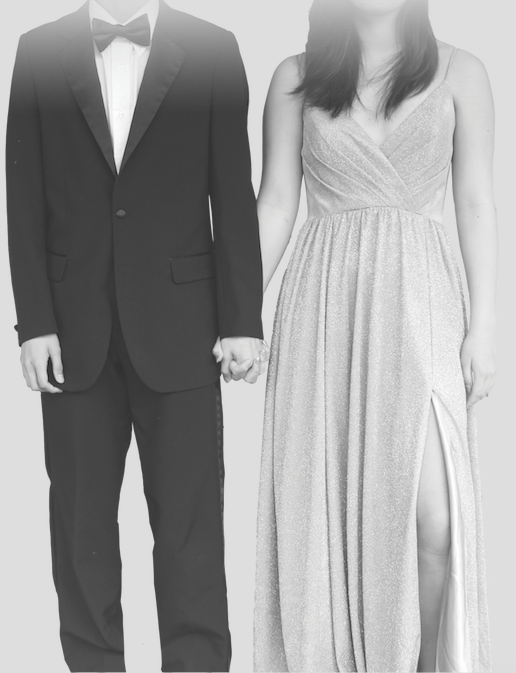Rising prom costs prompt reappraisal of experience, discourage participation
If you’re a junior, senior or lucky underclassman, it’s that magical time of the school year again—the time when the days start getting longer and you’re barely dragging yourself through Advanced Placement testing. But none of that matters now. After all, you’re counting down the days to the annual upperclassman dance— prom. Judging by the social media posts, photoshoots, Noah Centineo Netflix movies and prom tux rental advertisements that portray high schoolers as six-foot-five supermodels, one could easily get the impression that the high school prom possesses some sort of magic. Yet, that magic comes with consequences: rising ticket costs, outfit costs and the effects of social pressure make going to prom an increasingly extortionate endeavor.
The growth in ticket prices is making prom more and more costly. In 2018, ticket costs rose for the first time in four years, increasing from $90 to $100 each at the early-bird price with an Associated Student Body (ASB) membership and $110 to $120 at the standard price, according to statistics provided by the Student Executive Council (SEC). Costs have jumped again this year, going up to $110 at the early-bird price with ASB membership and $130 at normal costs. According to Student Activities Director Lisa Hall, however, the money made from ticket sales almost entirely goes toward paying for the venue and other amenities. The venue this year, the San Francisco Exploratorium, was substantially more expensive than previous years’ venues. Ticket costs also pay for extra accommodations provided to promgoers, including food, the DJ, docents to run the exhibits, photo booths and other amenities. Despite these costs, prom is widely considered to be one of the most significant events in a student’s high school experience. Upperclassmen are expected and almost required to go to prom due to social pressure, yet these rising ticket prices are making this event increasingly inaccessible and inconvenient. In order to access an occasion universally considered to be central to the teenage experience, students must be willing to pay exorbitant sums.
The rising costs of prom lie not only in the tickets but also in the overwhelming prices of assorted prom-worthy attire. Students find themselves spending $919 on prom on average, according to the 2015 Visa Prom Spending Survey. Formal attire, including floor-length dresses and tuxedos can comprise up to half of this cost. According to Fortune magazine, dresses typically cost anywhere from $200 to $1000 and tuxedo rentals cost between $100 and $400, with boutonnieres and corsages racking up the cost. Additionally, girls are oftentimes expected to spend additional money on make-up, nails and hairdressers, while boys are traditionally looked upon to spend money on flowers, posters and other promposal equipment. Entire financial sectors have been built around prom. According to the market research company IBISWorld, the formalwear rental industry racks up to a billion dollars a year, with much of that cost being associated with prom season. Promgirl.com reported earnings of $19 million dollars last year, catering almost exclusively to prom-going high schoolers. While the commercialization of prom has benefited many in the industry, it is often at the expense of promgoers themselves and their families. Though students pay for their own prom gear on occasion, the burden of these costs generally falls to parents, who may be hesitant to spend hundreds or even thousands of dollars on what essentially amounts to a four-hour experience.
The most costly facet of prom, however, is the social pressure of attending. The culture of prom is, by nature, non-inclusive. People constantly feel the urge to try and outdo each other in terms of glamour. Social media, in general, tends to present a distorted view of reality. But because of prom, an event designed to be as glitzy and extravagant as possible, these views become even more flashy and aestheticized. Going to prom with a date is a well-known expectation, and people often can feel forced into uncomfortable or awkward situations. Though it is not explicitly stated, a common social trend is that people without dates are also quietly looked down upon, as many singles go in large groups in fear of being ostracized. This behavior seems to manifest itself exclusively during prom season, encouraging outdated and unwelcoming ideas of identity and personal insecurities.
The significance of prom, like the significance of any event or activity, ultimately amounts to what a person makes of it. A plethora of different activities and excursions lack the financial and social baggage of prom while still being just as, if not more, meaningful. Throwing a party of your own, reserving a dinner for two and even simply spending time with friends are just three of the countless different ways to have fun and celebrate.
Prom is often regarded as an experience unlike any other—a romanticized night of perfection that most students participate in just twice in their entire lifetimes. But given the financial and social baggage that prom carries with it, this perfection can hardly be worth it. The reality is that the costs of prom tickets, prom apparel and social pressure make the dance an increasingly unsavory prospect.
Your donation will support the student journalists of Henry M. Gunn High School. Your contribution will allow us to purchase equipment and cover our annual website hosting costs.


